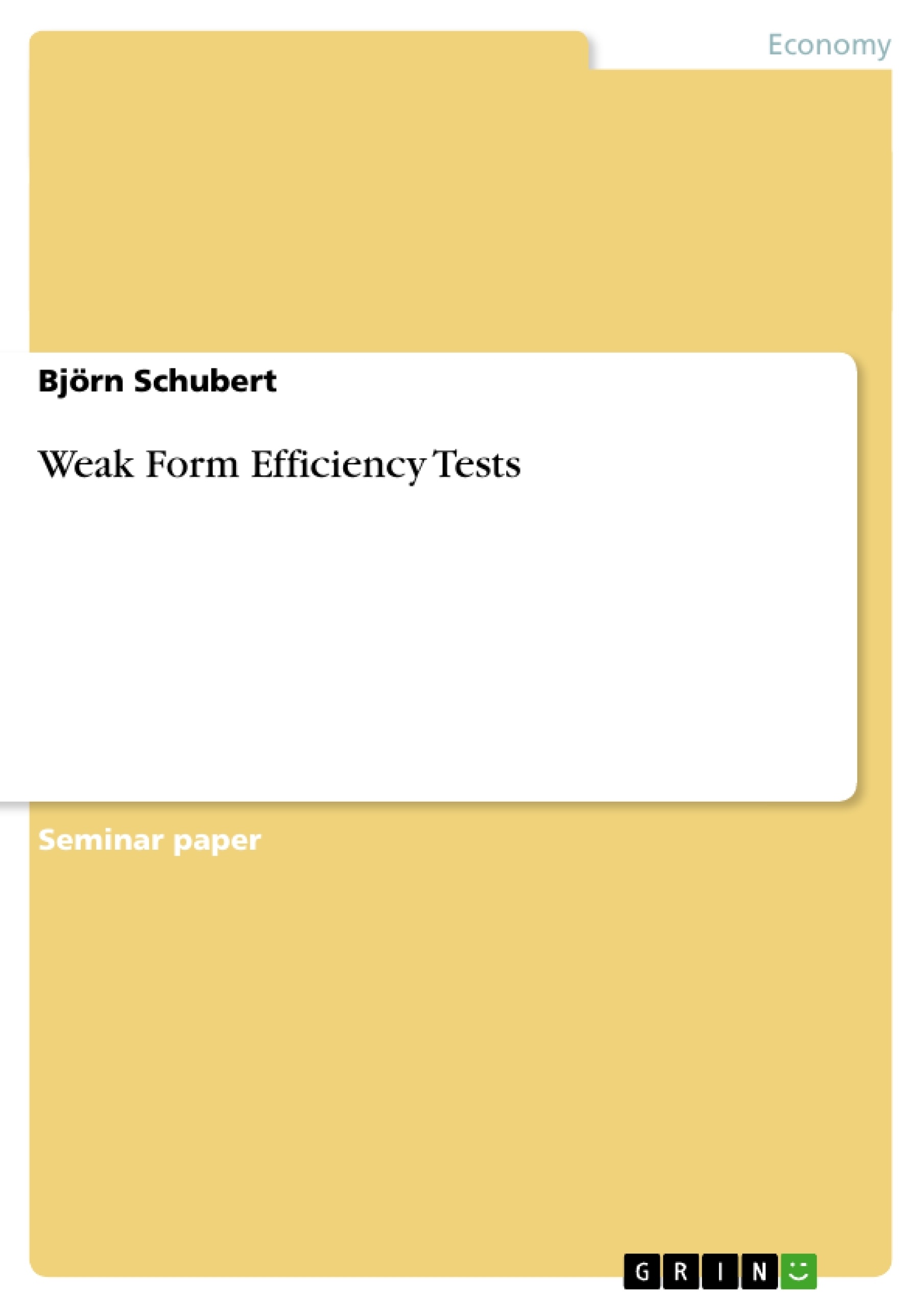While using standard tests of weak form market efficiency along with the more recent DELAY test, this report examines if the returns of six selected stocks and two decile indices follow a random walk which would evidence the non-predictability of future stock returns by historical prices which is a necessary condition for the weakest form of market efficiency. The evidence of four different measurement tests suggests that except of one stock all stocks and indices drift away from the weak form market efficiency hypothesis.
Inhaltsverzeichnis (Table of Contents)
- I. Companies overview
- II. Data and Methodology
- A. Data
- B. Methods
- III. Descriptive statistics
- IV. Results
- V. Concluding remarks
Zielsetzung und Themenschwerpunkte (Objectives and Key Themes)
This report investigates the weak form efficiency of the stock market using six selected stocks and two decile indices. The primary objective is to determine if the returns of these assets follow a random walk, a key characteristic of weak-form market efficiency. This involves testing whether past price information can predict future returns.
- Weak Form Market Efficiency
- Random Walk Hypothesis
- Statistical Tests of Market Efficiency
- Analysis of Stock Returns
- Empirical Evidence in Finance
Zusammenfassung der Kapitel (Chapter Summaries)
I. Companies overview: This chapter provides brief overviews of six selected companies (three from the NYSE and three from the NASDAQ), including their business activities, industry sectors, and stock exchange listings. Each company description highlights the nature of their operations, providing context for the subsequent market efficiency analysis. This section establishes the foundational information regarding the specific assets under investigation in the report.
II. Data and Methodology: This section details the data used and the methodology applied to test the weak form efficient market hypothesis. The data encompasses daily and monthly returns for the six selected stocks and two decile indices from January 2002 to December 2006. The chapter describes the calculation of log-returns and arithmetic returns, clarifying the formulas used. It also identifies the CRSP database as the source for price data and explains the three types of random walk models employed (RW1, RW2, RW3) in the efficiency test, referencing Campbell, Lo, and MacKinlay (1997).
Frequently Asked Questions: Comprehensive Language Preview
What is the purpose of this report?
This report investigates the weak form efficiency of the stock market. Its primary objective is to determine if the returns of six selected stocks and two decile indices follow a random walk, a key characteristic of weak-form market efficiency. The analysis focuses on whether past price information can predict future returns.
What companies are included in the analysis?
The report analyzes six selected companies: three from the NYSE and three from the NASDAQ. Specific company names are not provided in this preview, but Chapter I provides detailed overviews of each, including their business activities, industry sectors, and stock exchange listings.
What data is used in the report?
The report utilizes daily and monthly returns for the six selected stocks and two decile indices. This data spans from January 2002 to December 2006 and was sourced from the CRSP database. The analysis includes calculations of both log-returns and arithmetic returns.
What methodology is employed to test market efficiency?
The report employs three types of random walk models (RW1, RW2, RW3), as referenced in Campbell, Lo, and MacKinlay (1997), to test the weak form efficient market hypothesis. The chapter detailing the methodology also clarifies the formulas used for return calculations.
What are the key themes explored in the report?
Key themes include weak form market efficiency, the random walk hypothesis, statistical tests of market efficiency, analysis of stock returns, and empirical evidence in finance.
What is included in the Table of Contents?
The table of contents includes sections on Companies Overview, Data and Methodology (including subsections on Data and Methods), Descriptive Statistics, Results, and Concluding Remarks.
What is covered in the Chapter Summaries?
Chapter summaries provide detailed overviews of each chapter's content. The summary of Chapter I describes the overview of the six selected companies. The summary of Chapter II details the data sources and methodology used in testing the weak form efficient market hypothesis, including the random walk models employed.
- Quote paper
- Björn Schubert (Author), 2009, Weak Form Efficiency Tests, Munich, GRIN Verlag, https://www.hausarbeiten.de/document/131805


